North American F-86 Sabre
The North American F-86 Sabre, sometimes called the Sabrejet, is a transonic jet fighter aircraft. Produced by North American Aviation, the Sabre is best known as the United States' first swept-wing fighter that could counter the swept-wing Soviet MiG-15 in high-speed dogfights in the skies of the Korean War (1950–1953), fighting some of the earliest jet-to-jet battles in history. Considered one of the best and most important fighter aircraft in that war, the F-86 is also rated highly in comparison with fighters of other eras.[3] Although it was developed in the late 1940s and was outdated by the end of the 1950s, the Sabre proved versatile and adaptable and continued as a front-line fighter in numerous air forces until the last active operational examples were retired by the Bolivian Air Force in 1994.
| F-86 Sabre | |
|---|---|
.jpg) | |
| A North American F-86 over the Planes of Fame Air Museum in Chino, California | |
| Role | Fighter aircraft |
| National origin | United States |
| Manufacturer | North American Aviation |
| First flight | 1 October 1947 |
| Introduction | 1949, with USAF |
| Retired | 1965 (USAF) 1994 (Bolivia) |
| Status | Retired, some still used as warbirds |
| Primary users | United States Air Force Japan Air Self-Defense Force Spanish Air Force Republic of Korea Air Force |
| Number built | 9,860[1] |
| Unit cost |
US$219,457 (F-86E)[2] |
| Developed from | North American FJ-1 Fury |
| Variants | CAC Sabre Canadair Sabre North American F-86D Sabre North American FJ-2/-3 Fury |
| Developed into | North American FJ-4 Fury North American YF-93 North American F-100 Super Sabre |
Its success led to an extended production run of more than 7,800 aircraft between 1949 and 1956, in the United States, Japan, and Italy. In addition, 738 carrier-modified versions were purchased by the US Navy as FJ-2s and -3s. Variants were built in Canada and Australia. The Canadair Sabre added another 1,815 airframes, and the significantly redesigned CAC Sabre (sometimes known as the Avon Sabre or CAC CA-27), had a production run of 112. The Sabre is by far the most-produced Western jet fighter, with total production of all variants at 9,860 units.[1]
Development
North American Aviation had produced the propeller-powered P-51 Mustang in World War II, which saw combat against some of the first operational jet fighters. By late 1944, North American proposed its first jet fighter to the U.S. Navy, which became the FJ-1 Fury. It was an unexceptional transitional jet fighter that had a straight wing derived from the P-51.[4][5] Initial proposals to meet a United States Army Air Forces (USAAF) requirement for a medium-range, single-seat, high-altitude, jet-powered day escort fighter/fighter bomber were drafted in mid-1944.[6] In early 1945, North American Aviation submitted four designs.[6] The USAAF selected one design over the others, and granted North American a contract to build three examples of the XP-86 ("experimental pursuit"). Deleting specific requirements from the FJ-1 Fury, coupled with other modifications, allowed the XP-86 to be lighter and considerably faster than the Fury, with an estimated top speed of 582 mph (937 km/h), versus the Fury's 547 mph (880 km/h).[6] Despite the gain in speed, early studies revealed the XP-86 would have the same performance as its rivals, the XP-80 and XP-84. Because these rival designs were more advanced in their development stages, it was feared that the XP-86 would be cancelled.
Crucially, the XP-86 was not able to meet the required top speed of 600 mph (970 km/h);[7] North American had to quickly devise a radical change that could leapfrog its rivals. The North American F-86 Sabre was the first American aircraft to take advantage of flight research data seized from the German aerodynamicists at the end of World War II.[8] These data showed that a thin, swept wing could greatly reduce drag and delay compressibility problems that had bedeviled fighters such as the Lockheed P-38 Lightning when approaching the speed of sound. By 1944, German engineers and designers had established the benefits of swept wings based on experimental designs dating back to 1940. Study of the data showed that a swept wing would solve their speed problem, while a slat on the wing's leading edge that extended at low speeds would enhance low-speed stability.
Because development of the XP-86 had reached an advanced stage, the idea of changing the sweep of the wing was met with resistance from some senior North American staff. Despite stiff opposition, after good results were obtained in wind tunnel tests, the swept-wing concept was eventually adopted. Performance requirements were met by incorporating a 35° swept-back wing, using modified NACA four-digit airfoils, NACA 0009.5–64 at the root and NACA 0008.5–64 at the tip,[9] with an automatic slat design based on that of the Messerschmitt Me 262 and an electrically adjustable stabilizer, another feature of the Me 262A.[10][11][12] Many Sabres had the "6–3 wing" (a fixed leading edge with a 6-inch extended chord at the root and a 3-inch extended chord at the tip) retrofitted after combat experience was gained in Korea.[10][13] This modification changed the wing airfoils to the NACA 0009-64 mod at the root and the NACA 0008.1–64 mod at the tip.[9]
The XP-86 prototype, which led to the F-86 Sabre, was rolled out on 8 August 1947.[14] The first flight occurred on 1 October 1947 with George Welch at the controls,[15] flying from Muroc Dry Lake (now Edwards AFB), California.[8][14]
The United States Air Force's Strategic Air Command had F-86 Sabres in service from 1949 through 1950. The F-86s were assigned to the 22nd Bomb Wing, the 1st Fighter Wing, and the 1st Fighter Interceptor Wing.[16] The F-86 was the primary U.S. air combat fighter during the Korean War, with significant numbers of the first three production models seeing combat.
The F-86 Sabre was also produced under license by Canadair, Ltd, as the Canadair Sabre. The final variant of the Canadian Sabre, the Mark 6, is generally rated as having the highest capabilities of any Sabre version.[17][Note 1]
Breaking sound barrier and other records

The F-86A set its first official world speed record of 671 miles per hour (1,080 km/h) on September 15, 1948, at Muroc Dry Lake, flown by Major Richard L. Johnson, USAF.[18] Five years later, on 18 May 1953, Jacqueline Cochran became the first woman to break the sound barrier, flying a "one-off" Canadian-built F-86 Sabre Mk 3, alongside Chuck Yeager.[2] Col. K. K. Compton won the 1951 Bendix air race in an F-86A with an average speed of 553.76 mph (891.19 km/h).
Design
Overview
The F-86 was produced as both a fighter-interceptor and fighter-bomber. Several variants were introduced over its production life, with improvements and different armament implemented (see below). The XP-86 was fitted with a General Electric J35-C-3 jet engine that produced 4,000 lbf (18 kN) of thrust. This engine was built by GM's Chevrolet division until production was turned over to Allison.[19] The General Electric J47-GE-7 engine was used in the F-86A-1 producing a thrust of 5,200 lbf (23 kN), while the General Electric J73-GE-3 engine of the F-86H produced 9,250 lbf (41 kN) of thrust.[20]
The fighter-bomber version (F-86H) could carry up to 2,000 lb (907 kg) of bombs, including an external fuel-type tank that could carry napalm.[21] Unguided 2.75 in (70 mm) rockets were used on some fighters on training missions, but 5-inch (127 mm) rockets were later carried on combat operations. The F-86 could also be fitted with a pair of external jettisonable jet fuel tanks (four on the F-86F beginning in 1953) that extended the range of the aircraft. Both the interceptor and fighter-bomber versions carried six 0.50 in (12.7 mm) M3 Browning machine guns with electrically boosted feed in the nose (later versions of the F-86H carried four 20 mm (0.79 in) cannon instead of machine guns). Firing at a rate of 1,200 rounds per minute,[22] the 0.50 in guns were harmonized to converge at 1,000 ft (305 m) in front of the aircraft, using armor-piercing (AP) and armor-piercing incendiary (API) rounds, with one armor-piercing incendiary tracer (APIT) for every five AP or API rounds. The API rounds used during the Korean War contained magnesium, which were designed to ignite upon impact, but burned poorly above 35,000 ft (11,000 m) as oxygen levels were insufficient to sustain combustion at that height. Initial planes were fitted with the Mark 18 manual-ranging computing gun sight. The last 24 F-86A-5-Nas and F-86Es were equipped with the A-1CM gunsight-AN/APG-30 radar, which used radar to automatically compute a target's range, which later proved to be advantageous against MiG opponents over Korea.[23]
Flying characteristics
The Sabre's swept wings and jet engine produced a flying experience that was very different from the propeller-driven fighters of the time. The transition from props to jets was not without accidents and incidents even for experienced fighter pilots. Early on in the jet age, some US manufacturers instituted safety and transition programs where experienced test and production pilots toured operational fighter squadrons to provide instruction and demonstrations designed to lower the accident rate.[24]
Additionally, the ongoing technical development and long production history of the F-86 resulted in some significant differences in the handling and flying characteristics between the various F-86 models. Some of the important changes to the design included the switch from an elevator/stabilizer to an all-flying tail, the discontinuation of leading edge slats for a solid leading edge with increased internal fuel capacity, increased engine power, and an internal missile bay (F-86D). Each of these design changes impacted the handling and flying characteristics of the F-86, not necessarily for the better. In the case of the solid leading edge and increased internal fuel capacity, the design change produced increased combat performance, but exacerbated a dangerous and often fatal handling characteristic upon take-off if the nose were raised prematurely from the runway.[25] This 'over-rotation' danger is now a major area of instruction and concern for current F-86 pilots. The 1972 Sacramento Canadair Sabre accident resulting in 22 fatalities and 28 other casualties was a result of over-rotation on take-off.
Operational history
Korean War
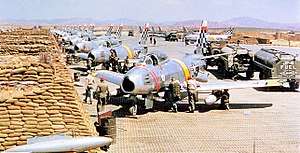
The F-86 entered service with the USAF in 1949, joining the 1st Fighter Wing's 94th Fighter Squadron and became the primary air-to-air jet fighter used by the Americans in the Korean War. While earlier straight-winged jets such as the F-80 and F-84 initially achieved air victories, when the swept-wing Soviet MiG-15 was introduced in November 1950, it outperformed all UN-based aircraft. In response, three squadrons of F-86s were rushed to the Far East in December.[26] Early variants of the F-86 could not out turn, but they could out dive the MiG-15, although the MiG-15 was superior to the early F-86 models in ceiling, acceleration, rate of climb, and zoom. With the introduction of the F-86F in 1953, the two aircraft were more closely matched, with many combat-experienced pilots claiming a marginal superiority for the F-86F. The heavier firepower of the MiG (and many other contemporary fighters) was addressed by fielding eight cannon-armed F-86s in the waning months of the war. Despite being able to fire only two of the four 20 mm cannon at a time, the experiment was considered a success.[27] The MiGs flown from bases in Manchuria by Chinese, North Korean, and Soviet VVS pilots were pitted against two squadrons of the 4th Fighter-Interceptor Wing forward-based at K-14, Kimpo, Korea.[26] In October 1951, the Soviets managed to recover a downed Sabre, and in their investigation of the type they concluded that the Sabre's advantage in combat was due to the APG-30 gun-sight that facilitated accurate fire at longer ranges.[23]
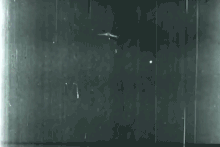
Many of the American pilots were experienced World War II veterans, while the North Koreans and the Chinese lacked combat experience, thus accounting for much of the F-86's success.[28] However, United Nations pilots suspected many of the MiG-15s were being flown by experienced Soviet pilots who also had combat experience in World War II. Former Communist sources now acknowledge Soviet pilots initially flew the majority of MiG-15s that fought in Korea, and dispute that more MiG-15s than F-86s were shot down in air combat. Later in the war, North Korean and Chinese pilots increased their participation as combat flyers.[29][30] The North Koreans and their allies periodically contested air superiority in MiG Alley, an area near the mouth of the Yalu River (the boundary between Korea and China) over which the most intense air-to-air combat took place. Although the F-86A could be safely flown through Mach 1, the F-86E's all-moving tailplane greatly improved maneuverability at high speeds.[27] The MiG-15 could not safely exceed Mach 0.92, an important disadvantage in near-sonic air combat. Far greater emphasis had been given to the training, aggressiveness, and experience of the F-86 pilots.[28] American Sabre pilots were trained at Nellis, where the casualty rate of their training was so high, they were told, "If you ever see the flag at full staff, take a picture." Despite rules of engagement to the contrary, F-86 units frequently initiated combat over MiG bases in the Manchurian "sanctuary".[29] The hunting of MiGs in Manchuria would lead to many reels of gun camera footage being 'lost' if the reel revealed the pilot had violated Chinese airspace.
The needs of combat operation balanced against the need to maintain an adequate force structure in Western Europe led to the conversion of the 51st Fighter-Interceptor Wing from the F-80 to the F-86 in December 1951. Two fighter-bomber wings, the 8th and 18th, converted to the F-86F in the spring of 1953.[31] No. 2 Squadron, South African Air Force also distinguished itself flying F-86s in Korea as part of the 18 FBW.[32]
On 17 June 1951, at 01:30 hours, Suwon Air Base was bombed by two Polikarpov Po-2 biplanes. Each Po-2 dropped a pair of fragmentation bombs: one scored a hit on the 802nd Engineer Aviation Battalion's motor pool, damaging some equipment. Two bombs burst on the flightline of the 335th Fighter Interceptor Squadron. One F-86A Sabre (FU-334 / 49-1334) was struck on the wing and began burning. The fire took hold, gutting the aircraft. Prompt action by personnel who moved aircraft away from the burning Sabre prevented further loss. Eight other Sabres were damaged in the brief attack, four seriously. One F-86 pilot was among the wounded. The North Koreans subsequently credited Lt. La Woon Yung with this damaging attack.[33]
By the end of hostilities, F-86 pilots were credited with shooting down 792 MiGs for a loss of only 78 Sabres in air-to-air combat, a victory ratio of 10:1.[34] Of the 41 American pilots who earned the designation of ace during the Korean War, all but one flew the F-86 Sabre, the exception being a Navy Vought F4U Corsair night fighter pilot. However, after the war the USAF reviewed its figures in an investigation code-named Sabre Measure Charlie and downgraded the kill ratio of the North American F-86 Sabre against the Mikoyan-Gurevich MiG-15 by half.[35] Internally, the USAF accepted that its pilots in fact downed ~ 200 MiGs[36]
According to Soviet data, the Soviets lost 335 MiG-15s in Korea to all causes, including accidents, antiaircraft fire, and ground attacks.[37] Chinese claims of their losses amount to 224 MiG-15s in Korea.[38] North Korean losses are not known, but according to North Korean defectors, their air force lost around 100 MiG-15s during the war.[39] Thus, 659 MiG-15s are admitted as being lost, many of these to F-86 Sabres[40] The Soviets claimed to have downed over 600 Sabres,[41] together with the Chinese claims (211 F-86s shot-down), although these cannot be reconciled with the number Sabres recorded as lost by the US.[42]
The status of many claimed air-to-air victories in the Korean War has been increasingly debated as more data becomes available, showing that instances of over-claiming abounded on both sides. The research by Dorr, Lake and Thompson claimed a F-86's kill ratio closer to 2:1.[43] A recent RAND report made reference to "recent scholarship" of F-86 v MiG-15 combat over Korea and concluded that the actual kill:loss ratio for the F-86 was 1.8:1 overall, and likely closer to 1.3:1 against MiGs flown by Soviet pilots.[44] However, this ratio were not count the number of aircraft of other types (B-29, A-26, F-80, F-82, F-84...) were shot down by MiG-15s.
Data-matching with Soviet records shows that US pilots routinely attributed their own combat losses to "landing accidents" and "other causes".[45] According to official US data ("USAF Statistical Digest FY1953"), the USAF lost 250 F-86 fighters in Korea. Of these, 184 were lost in combat (78 in air-to-air combat, 19 by anti-aircraft guns, 26 were "unknown causes" and 61 were "other losses") and 66 in incidents.[46] South African Air Force lost 6 F-86s in the war.[47] This gives 256 confirmed F-86 losses during the Korean War.
Cold War
In addition to its distinguished service in Korea, USAF F-86s also served in various stateside and overseas roles throughout the early part of the Cold War. As newer Century-series fighters came on line, F-86s were transferred to Air National Guard (ANG) units or the air forces of allied nations. The last ANG F-86s continued in U.S. service until 1970.
1958 Taiwan Strait crisis
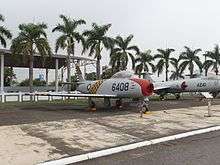
The Republic of China Air Force of Taiwan was an early recipient of surplus USAF Sabres. From December 1954 to June 1956, the ROC Air Force received 160 ex-USAF F-86F-1-NA through F-86F-30-NA fighters. By June 1958, the Nationalist Chinese had built up an impressive fighter force, with 320 F-86Fs and seven RF-86Fs having been delivered.[48]
Sabres and MiGs were shortly to battle each other in the skies of Asia once again in the Second Taiwan Strait Crisis. In August 1958, the Chinese Communists of the People's Republic of China attempted to force the Nationalists off of the islands of Quemoy and Matsu by shelling and blockade. Nationalist F-86Fs flying combat air patrol over the islands found themselves confronted by Communist MiG-15s and MiG-17s, and numerous dogfights resulted.
During these battles, the Nationalist Sabres introduced a new element into aerial warfare. Under a secret effort designated Operation Black Magic, the U.S. Navy had provided the ROC with the AIM-9 Sidewinder, its first infrared-homing air-to-air missile, which was just entering service with the United States. A small team from VMF-323, a Marine FJ-4 Fury squadron with later assistance from China Lake and North American Aviation, initially modified 20 of the F-86 Sabres to carry a pair of Sidewinders on underwing launch rails and instructed the ROC pilots in their use flying profiles with USAF F-100s simulating the MiG-17. The MiGs enjoyed an altitude advantage over the Sabres, as they had in Korea, and Communist Chinese MiGs routinely cruised over the Nationalist Sabres, only engaging when they had a favorable position. The Sidewinder took away that advantage and proved to be devastatingly effective against the MiGs.[49]
Indo-Pakistani War of 1965
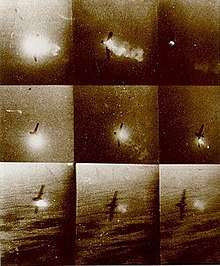
In 1954, Pakistan began receiving the first of a total of 120 F-86F Sabres. Many of these aircraft were F-86F-35s from USAF stocks, but some were from the later F-86F-40-NA production block, made specifically for export. Many of the −35s were brought up to −40 standards before they were delivered to Pakistan, but a few remained −35s. The F-86 was operated by nine Pakistan Air Force (PAF) squadrons at various times: Nos. 5, 11, 14, 15, 16, 17, 18, 19 and 26 Squadrons.
The Sabre was no longer a world-class fighter (due to availability of supersonic jets). However, many sources state the F-86 gave the PAF a technological advantage.[50][51][52]
Air to air combat
In the air-to-air combat of the Indo-Pakistani War of 1965, the PAF Sabres claimed to have shot down 15 Indian Air Force (IAF) aircraft, comprising nine Hunters, four Vampires, and two Gnats. India, however, admitted a loss of 14 combat aircraft to the PAF's F-86s.[53] The F-86s of the PAF had the advantage of being armed with AIM-9B/GAR-8 Sidewinder missiles, whereas none of its Indian adversaries had this capability. Despite this, the IAF claimed to have shot down four PAF Sabres in air-to-air combat.[54]
The Indian Air Force claimed that seven F-86 Sabres were shot down by Folland Gnats and six F-86 Sabres were shot down by Hawker Hunters.[54]
Ground attack
The aircraft remained a potent weapon for use against ground targets. On the morning of 6 September, six F-86s of No. 19 Sqn struck advancing columns of the Indian army using 5-in (127-mm) rockets along with their six .50-in (12.7-mm) M3 Browning machine guns. On the same day, eight F-86 fighters of the same squadron executed an attack against IAF Pathankot.[55] No. 14 PAF Squadron earned the nickname "Tailchoppers" for their successful attack against the Indian bomber base in Kalaikunda.[56]
PAF claims of destroying around 36 aircraft on the ground at various Indian airfields.[55][56][57] However, India only acknowledges 22 aircraft lost on the ground to strikes partly attributed to the PAF's F-86s and its bomber Martin B-57 Canberra.[53]
Indo-Pakistani War of 1971
The Canadair Sabres (Mark 6), acquired from ex-Luftwaffe stocks via Iran, were the mainstay of the PAF's day-fighter operations during the Indo-Pakistani War of 1971, and had the challenge of dealing with the threat from IAF.
At the beginning of the war, PAF had eight squadrons of F-86 Sabres.[58] Along with the newer fighter types such as the Mirage III and the Shenyang F-6, the Sabres were tasked with the majority of operations during the war. In East Pakistan, only one PAF F-86 squadron (14th Squadron) was deployed to face the numerical superiority of the IAF.
In the Battle of Boyra Indian MiG-21 and Folland Gnats shot down two F-86E and damaged one F-86E.[59]
PAF F-86s performed well, with Pakistani claims of downing 31 Indian aircraft in air-to-air combat. These included 17 Hawker Hunters, eight Sukhoi Su-7 "Fitters", one MiG 21, and three Gnats while losing seven F-86s. The most interesting of these was a battle between two Sabres and four MiG-21s. One MiG was shot down, without any Sabres lost. This was achieved due to better low-speed performance of the Sabre in comparison to the delta-winged MiG-21.[60]
India, however, claims to have shot down 11 PAF Sabres for the loss of 11 combat aircraft to the PAF F-86s.[61] The IAF numerical superiority overwhelmed the sole East Pakistan Sabres squadron (and other military aircraft)[59][62] which were either shot down, or grounded by Pakistani fratricide as they could not hold out, enabling complete air superiority for the IAF.[63]
After this war, Pakistan slowly phased out its F-86 Sabres and replaced them with Chinese F-6 (Soviet MiG-19 based) fighters. The last of the Sabres were withdrawn from service in PAF in 1980. They are now displayed in Pakistan Air Force Museum and in the cities in which their pilots lived.
Guinea-Bissau War of Independence
In 1958, the Forca Aerea Portuguesa (FAP) received 50 F-86Fs from ex-USAF stocks. A few former Norwegian Air Force F-86Fs were also purchased as spares in 1968–69.
The FAP deployed some of its F-86F Sabres to Portuguese Guinea in 1961, being based at AB2 – Bissalanca Air Base, Bissau. These aircraft formed "Detachment 52", initially equipped with eight F-86Fs (serials: 5307, 5314, 5322, 5326, 5354, 5356, 5361, and 5362) from the Esquadra 51, based at the BA5 – Monte Real Air Base. These aircraft were used in the Guinea-Bissau War of Independence, in ground-attack and close-support operations against the insurgent forces. In August 1962, 5314 overshot the runway during emergency landing with bombs still attached on underwing hardpoints and burned out. F-86F 5322 was shot down by enemy ground fire on 31 May 1963; the pilot ejected safely and was recovered. Several other aircraft suffered combat damage, but were repaired.
In 1964, 16 F-86Fs based at Bissalanca returned to mainland Portugal due to U.S. pressure. They had flown 577 combat sorties, of which 430 were ground-attack and close-air-support missions.
Philippine Air Force
The Philippine Air Force (PhAF) first received the Sabres in the form of F-86Fs in 1957, replacing the North American P-51 Mustang as their primary interceptor. F-86s first operated from Basa Air Base, known infamously as the "Nest of Vipers", where the 5th Fighter Wing of the PhAF was based. Later on, in 1960, the PhAF acquired the F-86D as their first all-weather interceptor. The most notable use of the F-86 Sabres was in the Blue Diamonds aerobatic display team, which operated eight Sabres until the arrival of the newer, supersonic Northrop F-5. The F-86s were subsequently phased out of service in the 1970s as the Northrop F-5 Freedom Fighter and Vought F-8 Crusaders became the primary fighters and interceptors of the PhAF. Antonio Bautista was a Blue Diamonds pilot and a decorated officer. He was killed on 11 January 1974 during a combat sortie against rebels in the south of the country.[64]
Soviet Sabre
During the Korean War, the Soviets were searching for an intact U.S. F-86 Sabre for evaluation/study purposes. Their search was frustrated, largely due to the U.S. military's policy of destroying their weapons and equipment once they had been disabled or abandoned; in the case of U.S. aircraft, USAF pilots destroyed most of their downed Sabres by strafing or bombing them. However, on one occasion, an F-86 was downed in the tidal area of a beach and subsequently was submerged, preventing its destruction. The aircraft was ferried to Moscow and a new OKB (Soviet Experimental Design Bureau) was established to study the F-86, which later became part of the Sukhoi OKB. "At least one F-86… was sent to the Soviet Union, the Russians [sic] admitted, and other planes and prizes such as U.S. G-suits and radar gun sights also went."[65] The Soviets studied and copied the optical gunsight and radar from the captured aircraft to produce the ASP-4N gunsight and SRC-3 radar. Installed in the MiG-17, the gunsight system was later used against American fighters in the Vietnam War.[Note 2]The F-86 studies also contributed to the development of aircraft aluminum alloys such as V-95.[67]
Feather Duster
The old but nimble MiG-17 had become such a serious threat against the Republic F-105 Thunderchief over North Vietnam that the USAF created project "Feather Duster" to test which tactics supersonic American fighters could use against fighters such as the MiG-17. ANG F-86H units proved to be an ideal stand-in for the Soviet jets. One pilot remarked, "In any envelope except nose down and full throttle", either the F-100 or F-105 was inferior to the F-86H in a dogfight.[68][69]
Variants
North American F-86
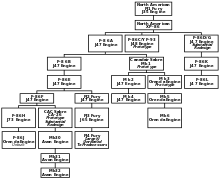
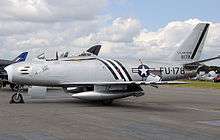
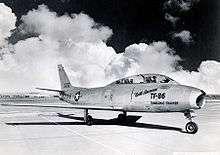
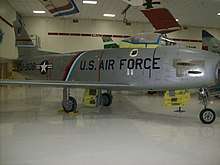
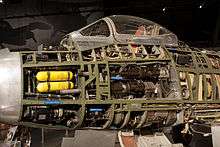
- XF-86
- three prototypes, originally designated XP-86, North American model NA-140
- YF-86A
- this was the first prototype fitted with a General Electric J47 turbojet engine.
- F-86A
- 554 built, North American model NA-151 (F-86A-1 block and first order of A-5 block) and NA-161 (second F-86A-5 block)
- DF-86A
- A few F-86A conversions as drone directors
- RF-86A
- 11 F-86A conversions with three cameras for reconnaissance
- F-86B
- 188 ordered as upgraded A-model with wider fuselage and larger tires but delivered as F-86A-5, North American model NA-152
- F-86C
- original designation for the YF-93A, two built, 48–317 & 48–318,[70] order for 118 cancelled, North American model NA-157
- YF-86D
- prototype all-weather interceptor originally ordered as YF-95A, two built but designation changed to YF-86D, North American model NA-164
- F-86D/L
- Production transonic all-weather search-radar equipped interceptor originally designated F-95A, 2,506 built. The F-86D had only 25 percent commonality with other Sabre variants, with a larger fuselage, larger afterburning engine, and a distinctive nose radome. Sole armament was Mk. 4 unguided rockets instead of machine guns. F-86Ls were upgraded F-86Ds.
- F-86E
- Improved flight control system and an "all-flying tail" (This system changed to a full power-operated control with an "artificial feel" built into the aircraft's controls to give the pilot forces on the stick that were still conventional, but light enough for superior combat control. It improved high-speed maneuverability); 456 built, North American model NA-170 (F-86E-1 and E-5 blocks), NA-172, essentially the F-86F airframe with the F-86E engine (F-86E-10 and E-15 blocks); 60 of these built by Canadair for USAF (F-86E-6)
- F-86E(M)
- Designation for ex-RAF Sabres diverted to other NATO air forces
- QF-86E
- Designation for surplus RCAF Sabre Mk. Vs modified to target drones
- F-86F
- Uprated engine and larger "6–3" wing without leading edge slats, 2,239 built; North American model NA-172 (F-86F-1 through F-15 blocks), NA-176 (F-86F-20 and −25 blocks), NA-191 (F-86F-30 and −35 blocks), NA-193 (F-86F-26 block), NA-202 (F-86F-35 block), NA-227 (first two orders of F-86F-40 blocks comprising 280 aircraft that reverted to leading edge wing slats of an improved design), NA-231 (70 in third F-40 block order), NA-238 (110 in fourth F-40 block order), and NA-256 (120 in final F-40 block order); 300 additional airframes in this series assembled by Mitsubishi in Japan for Japanese Air Self-Defense Force. Sabre Fs had much improved high-speed agility, coupled with a higher landing speed of over 145 mph (233 km/h). The F-35 block had provisions for a new task: the nuclear tactical attack with one of the new small "nukes" ("second generation" nuclear ordnance). The F-40 had a new slatted wing, with a slight decrease of speed, but also a much better agility at high and low speed with a landing speed reduced to 124 mph (200 km/h). The USAF upgraded many of previous F versions to the F-40 standard. One E and two Fs were modified for improved performance via rocket boost.
- F-86F(R)
- F-86F-30 (52-4608) had a Rocketdyne AR2-3 with 3,000–6,000 lbf (13,344.66–26,689.33 N) thrust at 35,000 ft (10,668 m), giving a top speed of M1.22 at 60,000 ft (18,288 m).[27]
- F-86F-2
- Designation for 10 aircraft modified to carry the M39 cannon in place of the M3 .50 caliber machine gun "six-pack". Four F-86E-10s (serial numbers 51-2803, 2819, 2826 and 2836) and six F-86F-1s (serial numbers 51-2855, 2861, 2867, 2868, 2884 and 2900) were production-line aircraft modified in October 1952 with enlarged and strengthened gun bays, then flight tested at Edwards Air Force Base and the Air Proving Ground at Eglin Air Force Base in November. Eight were shipped to Japan in December, and seven forward-deployed to Kimpo Airfield as "Project GunVal" for a 16-week combat field trial in early 1953. Two were lost to engine compressor stalls after ingesting excessive propellant gases from the cannons.[71][Note 3][72]
- QF-86F
- About 50 former Japan Self-Defense Forces (JASDF) F-86F airframes converted to drones for use as targets by the U.S. Navy
- RF-86F
- Some F-86F-30s converted with three cameras for reconnaissance; also 18 Japan Self-Defense Forces (JASDF) aircraft similarly converted
- TF-86F
- Two F-86F converted to two-seat training configuration with lengthened fuselage and slatted wings under North American model NA-204
- YF-86H
- Extensively redesigned fighter-bomber model with deeper fuselage, uprated engine, longer wings and power-boosted tailplane, two built as North American model NA-187
- F-86H
- Production model, 473 built, with Low Altitude Bombing System (LABS) and provision for nuclear weapon, North American model NA-187 (F-86H-1 and H-5 blocks) and NA-203 (F-86H-10 block)
- QF-86H
- Target conversion of 29 airframes for use at United States Naval Weapons Center
- F-86J
- Single F-86A-5-NA, 49-1069, flown with Orenda turbojet under North American model NA-167 – same designation reserved for A-models flown with the Canadian engines but project not proceeded with
- F-86K
- F-86L
North American FJ Fury
- See: North American FJ-2/-3 Fury for production figures of U.S. Navy versions.
CAC Sabre (Australia)
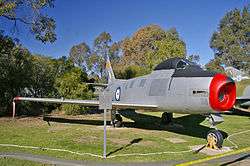
Two types based on the U.S. F-86F were built under licence by the Commonwealth Aircraft Corporation (CAC) in Australia, for the Royal Australian Air Force as the CA-26 (one prototype) and CA-27 (production variant). The RAAF operated the CA-27 from 1956 to 1971.[73] Ex-RAAF Avon Sabres were operated by the Royal Malaysian Air Force (TUDM) between 1969 and 1972. From 1973 to 1975, 23 Avon Sabres were donated to the Indonesian Air Force (TNI-AU); five of these were ex-Malaysian aircraft.[74]
The CAC Sabres included a 60% fuselage redesign, to accommodate the Rolls-Royce Avon Mk 26 engine, which had roughly 50% more thrust than the J47, as well as 30 mm Aden cannon and AIM-9 Sidewinder missiles. As a consequence of its powerplant, the Australian-built Sabres are commonly referred to as the Avon Sabre. CAC manufactured 112 of these aircraft.[75]
CA-27 marques:
- Mk 30: 21 built, wing slats, Avon 20 engine.
- Mk 31: 21 built, 6–3 wing, Avon 20 engine.
- Mk 32: 69 built, four wing pylons, F-86F fuel capacity, Avon 26 engine.[76]
Canadair Sabre
The F-86 was also manufactured by Canadair in Canada as the CL-13 Sabre to replace its de Havilland Vampires, with the following production models:
- Sabre Mk 1
- one built, prototype F-86A
- Sabre Mk 2
- 350 built, F-86E-type, 60 to USAF, three to RAF, 287 to RCAF
- Sabre Mk 3
- one built in Canada, test-bed for the Orenda jet engine
- Sabre Mk 4
- 438 built, production Mk 3, 10 to RCAF, 428 to RAF as Sabre F-4
- Sabre Mk 5
- 370 built, F-86F-type with Orenda engine, 295 to RCAF, 75 to Luftwaffe
- Sabre Mk 6
- 655 built, 390 to RCAF, 225 to Luftwaffe, six to Colombia and 34 to South Africa
Production summary
- NAA built a total of 6,297 F-86s and 1,115 FJs,
- Canadair built 1,815,
- Australian CAC built 112,
- Fiat built 221, and
- Mitsubishi built 300;
- for a total Sabre/Fury production of 9,860.
Production costs
| F-86A | F-86D | F-86E | F-86F | F-86H | F-86K | F-86L | |
|---|---|---|---|---|---|---|---|
| Program R&D cost | 4,707,802 | ||||||
| Airframe | 101,528 | 191,313 | 145,326 | 140,082 | 316,360 | 334,633 | |
| Engine | 52,971 | 75,036 | 39,990 | 44,664 | 214,612 | 71,474 | |
| Electronics | 7,576 | 7,058 | 6,358 | 5,649 | 6,831 | 10,354 | |
| Armament | 16,333 | 69,986 | 23,645 | 17,669 | 27,573 | 20,135 | |
| Ordnance | 419 | 4,138 | 3,047 | 17,117 | 4,761 | ||
| Flyaway cost | 178,408 | 343,839 | 219,457 | 211,111 | 582,493 | 441,357 | 343,839 |
| Maintenance cost per flying hour | 135 | 451 | 187 |
Note: The costs are in approximately 1950 United States dollars and have not been adjusted for inflation.[2]
Operators

- Source: F-86 Sabre Jet: History of the Sabre and FJ Fury[77]
.jpg)
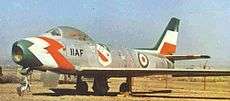
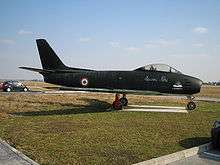
.jpg)
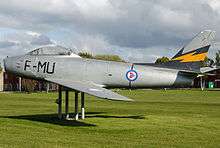
.jpg)
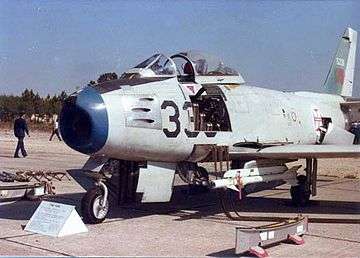
_(4).jpg)
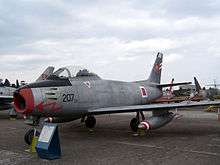
- Acquired 28 F-86Fs, 26 September 1960, FAA s/n CA-101 through CA-128. The Sabres were already on reserve status at the time of the Falklands War but were reinstated to active service to bolster air defences against possible Chilean involvement. Finally retired in 1986.
.svg.png)
- Belgian Air Force
- 5 F-86F Sabres delivered, no operational unit.
.svg.png)
- Royal Canadian Air Force (RCAF)
- Acquired four F-86Fs from Spanish Air Force (s/n 2027/2028), five USAF F-86F (s/n 51-13226) and other nine Canadair Mk.6; assigned to Escuadron de Caza-Bombardero.

- 59 F-86D-31NA(38) F-86D-36NA(21)s in service from 1958 – 1966 ESK 723, ESK 726, ESK 728[78]
.svg.png)
- German Air Force (Luftwaffe) – see North American F-86D Sabre and Canadair Sabre
- Acquired and 10 CL.13 Mk2 (F-86E) from Yugoslavia.
.svg.png)
- Imperial Iranian Air Force
- Acquired an unknown number of F-86Fs.[79]
.svg.png)
- Bought some units of the type but they were never operated and were returned.

- Japanese Air Self-Defense Force (JASDF)
- Acquired 180 U.S. F-86Fs, 1955–1957. Mitsubishi built 300 F-86Fs under license 1956–1961, and were assigned to 10 fighter hikōtai or squadrons. JASDF called F-86F the "Kyokukō" (旭光, Rising Sunbeam) and F-86D the "Gekkō" (月光, Moon Light). Their Blue Impulse Aerobatic Team, a total of 18 F-models were converted to reconnaissance version in 1962. Some aircraft were returned to the Naval Air Weapons Station China Lake, California, as drones.

- Acquired 115 F-86Fs, 1957–1958; and assigned to seven squadrons, Nos. 331, 332, 334, 336, 337, 338 and 339.

- Pakistani Air Force
- Acquired 102 U.S.-built F-86F-35-NA and F-86F-40-NAs, last of North American Aviation's production line, 1954–1960s.

- Acquired 26 U.S.-built F-86Fs in 1955, assigned to Escuadrón Aéreo 111, Grupo Aéreo No.11 at Talara air force base. Finally retired in 1979.
.svg.png)
- Acquired 50 F-86Fs in 1957. Retired in the late 1970s.

- A total of 65 acquired: 50 U.S.-built F-86Fs, 1958, including some from USAF's 531st Fighter Bomber Squadron, Chambley and 15 ex-Royal Norwegian Air Force. In Portugal, they served in Squadron 201 (formerly designated as Sqn. 50 and later Sqn. 51, before being renamed in 1978) and Squadron 52, both based at Air Base No. 5, Monte Real. In 1961, Portuguese Air Force deployed some of its F-86Fs to Portuguese Guinea, where they formed Detachment 52, based at Base-Aerodrome No. 2, Bissalanca/Bissau.

- Acquired 320 U.S.-built F-86Fs,7 RF-86Fs,18 F-86Ds, The 18 F-86Ds back to U.S. military and US send 6 to Republic of Korea Air Force,8 to Philippine Air Force in 1966.
.svg.png)
- Acquired 16 U.S.-built F-86Fs in 1958, and three Fs from Norway in 1966; and assigned to RSAF No. 7 Squadron at Dhahran.
.svg.png)
- Acquired on loan 22 U.S.-built F-86F-30s during the Korean War and saw action with 2 Squadron SAAF.

- Acquired U.S.-built 112 F-86Fs and 10 RF-86Fs, beginning 20 June 1955; and assigned to ROKAF 10th Wing. It also served with the ROKAF Black Eagles aerobatic team for annual event from 1959 to 1966. The last F-86s retired in 1990.
.svg.png)
- Acquired 270 U.S.-built F-86Fs, 1955–1958; designated C.5s and assigned to 5 wings: Ala de Caza 1, 2, 4, 5, and 6. Retired 1972.

- Acquired 40 U.S.-built F-86Fs, 1962; assigned to RTAF Squadrons, Nos. 12 (Ls), 13, and 43.
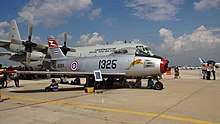
.svg.png)
- Acquired 15 used U.S.-built F-86F in 1969.

- Acquired 12 U.S.-built F-86Fs.

- Received 5 F-86E(M)s from Italy as MAP redeployment 1963, crewed by Philippine pilots; F-86F units from Ethiopia and Iran also used in ONUC.

.svg.png)
- Acquired 30 U.S.-built F-86Fs, October 1955 – December 1960; and assigned to one group, Grupo Aéreo De Caza No. 12, three other squadrons.
.svg.png)
- Yugoslav Air Force
- Acquired 121 Canadair CL-13s and F-86Es, operating them in several fighter aviation regiments between 1956 and 1971.
Civil aviation
According to the FAA there are 50 privately owned and registered F-86s in the US, including Canadair CL-13 Sabres.[80][Note 4]
Notable pilots
- Sqn Ldr (later Air commodore) M. M. Alam, Pakistan Air Force, became a flying ace by shooting down five Indian Air Force fighters within one minute in the Indo-Pakistani War of 1965. He was awarded the Sitara-e-Jurat ("The star of courage") and bar.[81][82]
- Colonel Edwin "Buzz" Aldrin, USAF test pilot and NASA astronaut of Apollo 11 fame. Credited with shooting down two MiGs over Korea.
- Major Rudolf Anderson, Jr. USAF (4028th Strategic Reconnaissance Squadron). Shot down and killed in 1962 while flying a U-2 spy plane over Cuba during the Cuban Missile Crisis.
- Colonel Royal N. Baker (13 victories), commander USAF 4 FIW.
- Wing Commander John Robert Baldwin DSO & Bar, DFC & Bar, AFC was a Royal Air Force fighter pilot and the top scoring fighter ace flying the Hawker Typhoon exclusively during the Second World War. He was posted missing, presumed killed, during service with the United States Air Force in the Korean War flying a Sabre.
- Lieutenant Colonel Antonio Bautista of the Philippine Air Force received the Distinguished Conduct Star for his valor and bravery in providing close air support to ground forces.
- Major General Frederick C. Blesse (10 victories)
- 1st Lieutenant [Later Colonel] John Boyd, USAF, flying 22 missions in the F-86E and F models, with the 25th FIS (51st FIW) June–July 1953.
- 1st Lieutenant John M. Conroy, completed "Operation Boomerang" on May 21, 1955, a record setting coast-to-coast and back in one day during daylight hours of 5058 miles in 11 hours, 26 mins, 33 secs.
- Major George Davis (14 victories), USAF 4 FIW, awarded the Medal of Honor posthumously
- Captain Manuel "Pete" Fernandez, (14.5 victories), USAF 4 FIW
- Colonel Francis S. "Gabby" Gabreski (six and one-half victories), USAF 51 FIW commander, top European U.S. ace in World War II
- Colonel Vermont Garrison (five victories), USAF 4 FIW, ace in World War II and combat veteran of three wars
- Colonel Ralph "Hoot" Gibson (five victories), USAF 4 FIW
- Major John Glenn, a U.S. Marine Corps exchange pilot with the USAF 51 FIW (3 victories). First American astronaut to orbit the Earth, later a U.S. Senator from Ohio.
- Lieutenant Colonel Virgil "Gus" Grissom, astronaut in the Mercury, Gemini and Apollo programs, died in a fire during testing for the Apollo 1 mission.
- 1st Lieutenant Robert A. "Bob" Hoover,USAF 52 FIW, North American Aviation experimental engineering test pilot.[83]
- Captain James Horowitz (1 victory), USAF 4 FIW, novelist and author of The Hunters under the pen name James Salter
- Colonel James Jabara (15 victories), USAF 4 FIW
- Colonel James H. Kasler (six victories), USAF 4 FIW and only three-time recipient of the Air Force Cross
- Flying Officer Waleed Ehsanul Karim, Pakistan Air Force, youngest Sabre pilot (first flew Sabres when he was 18).
- Captain Iven Kincheloe (five victories) USAF 51 FIW, test pilot selected to fly the North American X-15
- Second Lieutenant Gene Kranz, NASA flight director for Gemini and Apollo and assistant flight director on Project Mercury- flew with 69th FBS in South Korea
- Squadron Leader Andy Mackenzie, DFC. RCAF Second World War fighter ace (8.5 victories); taken POW when his F-86 was shot down while flying with the USAF 51 FIW in Korea in 1952.[84]
- Colonel Walker "Bud" Mahurin, USAF 4 FIG commander and World War II ace
- Captain Joseph C. McConnell (16 victories), USAF 51 FIW, who later died in a crash at Edwards Air Force Base testing the F-86H
- General John C. Meyer (two victories), USAF 4 FIW commander and later Vice Chief of Staff of the USAF.
- Squadron Leader Sarfaraz Ahmed Rafiqui, PAF no. 5 squadron, awarded the Hilal-i-Jur'at during the Indo-Pakistani War of 1965
- Brigadier General James Robinson Risner (eight victories), USAF awarded the Air Force Cross, later Vietnam War POW
- Colonel Harrison R. Thyng (five victories), USAF 4 FIW commander
- Major General Howard Thomas Markey, first chief judge of the United States Court of Appeals for the Federal Circuit
- Lieutenant Commander Theodore H Faller, August 13, 1979 – U.S. Navy Lieutenant Commander Theodore "Ted" Faller was killed when his QF-86 Sabre suffered an engine failure moments after takeoff.[85] Faller managed to bring the stricken aircraft down in a vacant lot 600 yards south of the Ridgecrest Heights Elementary School, later renamed Theodore Faller Elementary School.[86]
Surviving aircraft
Specifications (F-86F-40-NA)
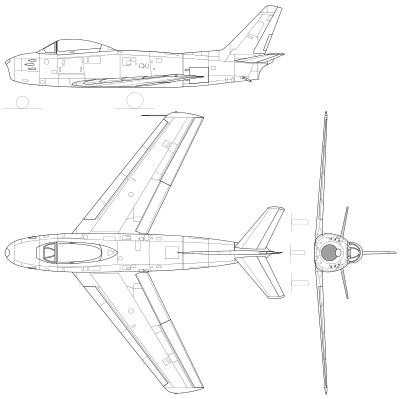
Data from The North American Sabre[87]
General characteristics
- Crew: 1
- Length: 37 ft 1 in (11.30 m)
- Wingspan: 37 ft 0 in (11.28 m)
- Height: 14 ft 1 in (4.29 m)
- Wing area: 313.4 sq ft (29.12 m2)
- Airfoil: root: NACA 0009-64 mod.; tip: NACA 0008.1-64 mod.[88]
- Empty weight: 11,125 lb (5,046 kg)
- Gross weight: 15,198 lb (6,894 kg)
- Max takeoff weight: 18,152 lb (8,234 kg)
- Fuel capacity: JP-4 fuel:- 437 US gallons (364 imp gal; 1,650 L) internals + 2x 200 US gallons (170 imp gal; 760 L) drop tanks
- Powerplant: 1 × General Electric J47-GE-27 turbojet engine, 5,910 lbf (26.3 kN) thrust
Performance
- Maximum speed: 687 mph (1,106 km/h, 597 kn) at sea level at 14,212 lb (6,446 kg) combat weight
- 678 mph (589 kn; 1,091 km/h) / M1.02
- 599 mph (521 kn; 964 km/h) at 35,000 ft (10,668 m) at 15,352 lb (6,964 kg)
- 597 mph (519 kn; 961 km/h) at 21,148 ft (6,446 m)
- 597 mph (519 kn; 961 km/h) at 21,148 ft (6,446 m)
- 599 mph (521 kn; 964 km/h) at 22,835 ft (6,960 m)
- Stall speed: 124 mph (200 km/h, 108 kn)
- Range: 1,525 mi (2,454 km, 1,325 nmi)
- Combat range: 414 mi (666 km, 360 nmi) with two 1,000 lb (454 kg) bombs and 2x 200 US gallons (170 imp gal; 760 L) drop tanks[89]
- Service ceiling: 49,600 ft (15,100 m) at combat weight
- Rate of climb: 9,000 ft/min (46 m/s) at sea level
- Time to altitude: 30,000 ft (9,144 m) in 5 minutes 12 seconds
- Lift-to-drag: 15
- Thrust/weight: 0.42
Armament
- Guns: 6 X 0.50 in (12.7 mm) M3 Browning machine guns (1,800 rounds in total)
- Rockets: variety of rocket launchers; e.g.: 2 Matra rocket pods with 18 SNEB 68 mm rockets per pod
- Bombs: 5,300 lb (2,400 kg) of payload on four external hardpoints, bombs were usually mounted on outer two pylons as the inner pairs were plumbed for 2 200 US gallons (760 L) drop tanks which gave the Sabre a more useful range. A wide variety of bombs could be carried (max standard loadout being two 1,000 lb bombs plus two drop tanks), napalm canisters and could have included a tactical nuclear weapon.
See also
- Aircraft in fiction#F-86 Sabre for notable appearances in the media.
- Semi-Automatic Ground Environment
- Tactical Air Command
Related development
- CAC Sabre
- Canadair Sabre
- North American F-86D Sabre
- North American F-100 Super Sabre
- North American FJ-1 Fury
- North American FJ-2/-3 Fury
- North American FJ-4 Fury
- North American YF-93
Aircraft of comparable role, configuration and era
- Dassault Mystère
- FMA IAe 33 Pulqui II
- Grumman F-9 Cougar
- Hawker Hunter
- Lavochkin La-15
- Mikoyan-Gurevich MiG-15
- Mikoyan-Gurevich MiG-17
- Republic F-84F Thunderstreak
- Saab 29 Tunnan
Related lists
References
Notes
- Quote: "The Canadair Sabre Mk 6 was the last variant and considered to be the 'best' production Sabre ever built."
- The MiG-17 was a development of the MiG-15 upgraded with a more advanced wing and afterburner (the Sabre's all-flying tail would not be employed until the supersonic MiG-19). The MiG-17 proved to be a deadly foe in Vietnam in the 1960s against more advanced U.S. supersonic opponents; some, such as the F-4 Phantom, actually lacked the guns and radar gunsight introduced by the F-86.[66]
- MiG Alley: Sabres Vs. MiGs Over Korea. was researched by North American tech rep John L. Henderson. The aircraft were F-86E-10s: 51-2303, -2819, -2826 and -2836; and F-86F-1's 51-2855, −2862, −2867, −2868, −2884 and −2900.
- Although privately registered in the US, two F-86s are actually owned by an individual for display purposes only in a private museum collection.[80]
Citations
- Winchester 2006, p. 184.
- Knaack 1978, p. 52.
- "MiG-15 'Fagot'." Archived 27 July 2011 at the Wayback Machine mnangmuseum.org. Retrieved: 19 July 2011.
- Goebel, Greg. "Sabre Ancestor: FJ-1 Fury." vectorsite.net. Retrieved: 19 July 2011.
- "FJ-1 Fury." globalsecurity.org. Retrieved: 20 August 2010.
- Werrell 2005, p. 5.
- Werrell 2005, p. 6.
- "North American F-86." Aviation History On-line Museum. Retrieved: 20 August 2010.
- Lednicer, David. "The Incomplete Guide to Airfoil Usage." Archived 20 April 2010 at the Wayback Machine ae.illinois.edu, 15 October 2010. Retrieved: 19 July 2011.
- Blair, Mac. "Evolution of the F-86" AIAA Evolution of Aircraft Wing Design Symposium, 18 March 1980.
- Radinger and Schick 1996, p. 15.
- Willy and Schick 1996, p. 32.
- Bevan, Duncan. "F-86 Sabre wings explained." Archived 26 July 2011 at the Wayback Machine tripod.com. Retrieved: 7 June 2011.
- Werrell 2005, pp. 9–10.
- "North American F-86 Sabre (Day-Fighter A, E and F Models)." Archived 24 February 2015 at the Wayback Machine National Museum of the United States Air Force. Retrieved: 7 June 2011.
- "Planes of Perrin, North American F-86L "Dog Sabre." perrinairforcebase.net. Retrieved: 20 August 2010.
- Joos 1971, p. 3.
- Wagner, The North American Sabre Retrieved: 20 August 2010.
- Leyes 1999, pp. 243, 530.
- Goebel, Greg (1 August 2002). "F-86E Through F-86L". faqs.org. Retrieved 27 November 2017.
- "North American F-86H Sabre". National Museum of the US Air Force. 29 May 2015. Retrieved 7 November 2017.
- Dunlap 1948, pp. 310–311.
- https://www.airspacemag.com/military-aviation/to-snatch-a-sabre-4707550/
- Hoover 1997, pp. 184–185.
- Hoover 1997, p. 184.
- Thompson, Warren. "Sabre: The F-86 in Korea." Flight Journal, December 2002. Retrieved: 30 June 2011.
- Ray Wagner, The North American Sabre
- "Fact Sheet: The United States Air Force in Korea." Archived 16 July 2007 at the Wayback Machine National Museum of the United States Air Force. Retrieved: 7 June 2011.
- " 'Bud' Mahurin." acepilots/com. Retrieved: 20 August 2010.
- Zampini, Diego. "Lt. Col. George Andrew Davis." acepilots.com, 8 July 2011. Retrieved: 20 August 2010.
- "USAF Organizations in Korea, Fighter-Interceptor 4th Fighter-Interceptor Wing." Maxwell Air Force Base. Retrieved: 30 June 2011.
- McGregor, Col. P. M. J. "The History of No 2 Squadron, SAAF, in the Korean War." rapidttp.com. Retrieved: 19 July 2011.
- American Aviation Historical Society, Vol. 30, 1985.
- Thompson and McLaren 2002
- Brune 1996, p. 215
- Stillion, John and Scott Perdue. "Air Combat Past, Present and Future." Archived 6 October 2012 at the Wayback Machine Project Air Force, Rand, August 2008. Retrieved" 11 March 2009.
- Igor Seidov and Stuart Britton. Red Devils over the Yalu: A Chronicle of Soviet Aerial Operations in the Korean War 1950–53 (Helion Studies in Military History). Helion and Company 2014. ISBN 978-1909384415. Page: 554.
- Zhang, Xiaoming. Red Wings over the Yalu: China, the Soviet Union, and the Air War in Korea (Texas A&M University Military History Series). College Station, Texas: Texas A&M University, 2002. ISBN 978-1-58544-201-0.
- Kum-Suk No and J. Roger Osterholm. A MiG-15 to Freedom: Memoir of the Wartime North Korean Defector who First Delivered the Secret Fighter Jet to the Americans in 1953. McFarland, 2007. ISBN 978-0786431069. Page 142.
- "Korean War Air Loss Database (KORWALD)" (PDF).
- Sewell, Stephen L. "Russian Claims from the Korean War 1950–53." Archived 1 November 2006 at the Wayback Machine korean-war.com. Retrieved: 19 July 2011.
- Zhang, Xiaoming. Red Wings over the Yalu: China, the Soviet Union, and the Air War in Korea. College Station, Texas: Texas A&M University Press, 2002. ISBN 1-58544-201-1.
- Dorr, Robert F., Jon Lake and Warren E. Thompson. Korean War Aces. London: Osprey Publishing, 2005. ISBN 1-85532-501-2.
- Stillion, John and Scott Perdue. "Air Combat Past, Present and Future." Archived 6 October 2012 at the Wayback Machine Project Air Force, Rand, August 2008. Retrieved" 11 March 2009.
- https://web.archive.org/web/20130604071241/http://www.acig.org/artman/publish/article_315.shtml
- USAF losses during the Korean War. USAF Statistical Digest FY1953
- ""Six were written off during action."/F-86F in Foreign Service. Joe Baugher. 1999". Archived from the original on 31 January 2019. Retrieved 21 February 2019.
- http://www.taipeitimes.com/News/feat/archives/2016/07/03/2003650222
- Robbins, Robby. "323 Death Rattlers." inreach.com. Retrieved" 20 August 2010.
- Hussain, Air Commodore Jamal (Ret'd) J. "Excellence in Air Combat: PAF's Forte." Pakistan's Defence Journal. Retrieved: 20 August 2010.
- "Pakistan's Air Power." Flight International, 5 May 1984, p. 1208 via FlightGlobal.com, Retrieved: 22 October 2009.
- "BBC report on PAF 1965." YouTube. Retrieved: 16 November 2012.
- "1965 Losses." Archived 21 July 2006 at the Wayback Machine bhart-rakshak.com. Retrieved: 20 August 2010.
- Rakshak, Bharat. "IAF Kills in 1965." Archived 5 November 2006 at the Wayback Machine bharat-rakshak.com. Retrieved: 20 August 2010.
- "Devastation of Pathankot." Defence Journal, September 2000. Retrieved: 20 August 2010.
- "Tail Choppers: Birth of a Legend." Defence Journal, December 1998. Retrieved:20 August 2010.
- "A Hero Fades Away." Defence Journal, Feb–Mar. 1999. Retrieved: 20 August 2010.
- ""India and Pakistan: Over the Edge." Time, 13 December 1971. Retrieved: 11 March 2009.
- "1971 Indo-Pakistani war." subcontinent.com. Retrieved: 30 June 2011.
- Tufail, Air Cdre M. Kaiser."It is the Man Behind the Gun." defencejournal.co, 2001. Retrieved: 25 November 2015.
- "IAF Losses in 1971." Archived 7 September 2006 at the Wayback Machine Bharat Rakshak.com. Retrieved: 20 August 2010.
- "Bangladesh, The Liberation War." memory/loc.gov. Retrieved: 30 June 2011.
- Singh et al. 2004, p. 30.
- "Antonio Bautista Air Base". Globalsecurity.org, 2009. Retrieved: 7 August 2013.
- Sauter, Mark. "Ghost pilots and mystery aircraft of the Korean War." Korean Confidential, 4 December 2012. Retrieved: 31 March 2013. Archived 15 February 2015 at the Wayback Machine
- Davies 2009, p. 21.
- "Soviet Sabre." Captured Planes. Retrieved: 30 June 2011.
- Michel 2007, p. 333.
- Davis, Larry H. "We interview Les Waltman." Archived 27 March 2012 at the Wayback Machine Sabre-pilots.org. Retrieved: 19 July 2011.
- "North American YF-93A Fact Sheet." Archived 27 October 2014 at the Wayback Machine National Museum of the United States Air Force. Retrieved: 20 August 2010.
- Thompson and McLaren 2002, pp. 139–155.
- http://www.dtic.mil/dtic/tr/fulltext/u2/031528.pdf
- "Sabre." RAAF Museum. Retrieved: 20 August 2010.
- Wilson 1989, p. 110.
- Wilson 1994, pp. 73–74.
- Wilson 1994, p. 74
- Dorr 1993, pp. 65–96.
- Schrøder 1991, p. 62.
- Baugher, Joe. "F-86 Foreign Service." USAAC/USAAF/USAF Fighter and Pursuit Aircraft: North American F-86 Sabre. Retrieved: 20 August 2010.
- "FAA Registry: F-86." FAA. Retrieved: 17 May 2011.
- Tufail, Air Cdre M. Kaiser. "Alam's Speed-shooting Classic." defencejournal.com. Retrieved: 20 August 2010.
- Pushpindar, Singh. Fiza ya: Psyche of the Pakistan Air Force. New Delhi: Himalayan Books, 1991. ISBN 81-7002-038-7.
- Hoover 1997, p. 145.
- "S/L Andy MacKenzie RCAF (Ret)." Archived 16 May 2008 at the Wayback Machine Sabre Jet Classics, Volume 10, Number 1, Winter 2003.
- "Faller, Theodore, LCDR." togetherweserved.com. Retrieved: 25 November 2015.
- Goldstrand, Theresa. "Faller's heroic act remembered by community." The New Review (Ridgecrest, California), 14 August 2014. Retrieved: 25 November 2015.
- Wagner 1963, p. 145.
- Lednicer, David. "The Incomplete Guide to Airfoil Usage". m-selig.ae.illinois.edu. Retrieved 16 April 2019.
- Futrell 2000, p. 639.
Bibliography
- Allward, Maurice. F-86 Sabre. London: Ian Allan, 1978. ISBN 0-7110-0860-4.
- Baldini, Atilio; Núñez Padin, Jorge F. (2009). Núñez Padin, Jorge Felix (ed.). F-86F-30-NA Sabre. Serie Fuerza Aérea (in Spanish). 16. Bahía Blanca, Argentina: Fuerzas Aeronavales. ISBN 978-987-20557-5-2. Archived from the original on 22 February 2013. Retrieved 20 May 2016.
- Curtis, Duncan. North American F-86 Sabre. Ramsbury, UK: Crowood, 2000. ISBN 1-86126-358-9.
- Davies, Peter. USN F-4 Phantom II vs VPAF MiG-17: Vietnam 1965–72. Oxford, UK: Oxford, 2009. ISBN 978-1-84603-475-6.
- Dorr, Robert F.F-86 Sabre Jet: History of the Sabre and FJ Fury. St. Paul, Minnesota: Motorbooks International Publishers, 1993. ISBN 0-87938-748-3.
- Futrell, Robert F. The United States Air Force in Korea, 1950-1953. Air Force History and Museums Program, 2000. ISBN 0-16-048879-6.
- Dunlap, Roy F. Ordnance Went Up Front. Plantersville, South Carolina: Samworth Press, 1948.
- Hoover, R.A. Forever Flying: Fifty Years of High-Flying Adventures, From Barnstorming in Prop Planes to Dogfighting Germans to Testing Supersonic Jets: An Autobiography. New York: Pocket Books, 1997. ISBN 978-0-6715-3761-6.
- Jenkins, Dennis R. and Tony R. Landis. Experimental & Prototype U.S. Air Force Jet Fighters. North Branch, Minnesota, USA: Specialty Press, 2008. ISBN 978-1-58007-111-6.
- Joos, Gerhard W. Canadair Sabre Mk 1–6, Commonwealth Sabre Mk 30–32 in RCAF, RAF, RAAF, SAAF, Luftwaffe & Foreign Service. Kent, UK: Osprey Publications Limited, 1971. ISBN 0-85045-024-1.
- Käsmann, Ferdinand C.W. Die schnellsten Jets der Welt: Weltrekord- Flugzeuge (in German). Oberhaching, Germany: Aviatic Verlag-GmbH, 1994. ISBN 3-925505-26-1.
- Knaack, Marcelle Size. Encyclopedia of US Air Force Aircraft and Missile Systems, Volume 1, Post-World War Two Fighters, 1945–1973. Washington, DC: Office of Air Force History, 1978. ISBN 0-912799-59-5.
- Leyes, Richard A. and William A. Fleming. The History of North American Small Gas Turbine Aircraft Engines. (Library of Flight Series) Washington, D.C.: AIAA, 1999. ISBN 978-1-56347-332-6.
- Michel, Marshall L., III. Clashes: Air Combat Over North Vietnam, 1965–1972. Annapolis, Maryland: Naval Institute Press, 2007. ISBN 978-1-59114-519-6.
- Radinger, Willy and Walter Schick. Me 262: Entwicklung und Erprobung des ertsen einsatzfähigen Düsenjäger der Welt, Messerschmitt Stiftung (in German). Berlin: Avantic Verlag GmbH, 1996. ISBN 3-925505-21-0.
- Robinson, Robbie NATO F-86D/K Sabre Dogs 120 p. Le Havre, France: Editions Minimonde76, 2018. ISBN 978-2-9541818-3-7.
- Schrøder, Hans. Royal Danish Airforce. Copenhagen, Denmark: Tøjhusmuseet, 1991. ISBN 87-89022-24-6.
- Singh, Sarina et al. Pakistan & the Karakoram Highway. London: Lonely Planet Publications, 2004. ISBN 0-86442-709-3.
- Swanborough, F. Gordon. United States Military Aircraft Since 1909. London: Putnam, 1963. ISBN 0-87474-880-1.
- Thompson, Warren E. and David R. McLaren. MiG Alley: Sabres vs. MiGs Over Korea. North Branch, Minnesota: Specialty Press, 2002. ISBN 1-58007-058-2.
- United States Air Force Museum Guidebook. Wright-Patterson AFB, Dayton, Ohio: Air Force Museum Foundation, 1975.
- Wagner, Ray. American Combat Planes – Second Edition. New York: Doubleday and Company, 1968. ISBN 0-370-00094-3.
- Wagner, Ray. The North American Sabre. London: Macdonald, 1963. No ISBN.
- Werrell, Kenneth P (2005). Sabres Over MiG Alley. Annapolis, Maryland: Naval Institute Press, 2005. ISBN 1-59114-933-9.
- Westrum, Ron. Sidewinder. Annapolis, Maryland: Naval Institute Press, 1999. ISBN 1-55750-951-4.
- Wilson, Stewart. Meteor, Sabre and Mirage in Australian Service. Weston Creek: Aerospace Publications, 1989. ISBN 0-9587978-2-X.
- Wilson, Stewart. Military Aircraft of Australia. Weston Creek: Aerospace Publications, 1994. ISBN 1-875671-08-0.
- Winchester, Jim, ed. Military Aircraft of the Cold War (The Aviation Factfile). London: Grange Books plc, 2006. ISBN 1-84013-929-3.
External links
| Wikimedia Commons has media related to North American F-86 Sabre. |
- F-86 Sabre Pilots Association
- Globalsecurity.org profile of the F-86 Sabre
- Four-part series about the F-86 Sabre – Extended F-86 Sabre article set
- Warbird Alley: F-86 Sabre page – Information about F-86s still flying today
- Sabre site
- F-86 in Joe Baugher's U.S. aircraft site
- Virtual view of F-86F (52-4959) NX86FR operated by the Valiant Air Command in Titusville, FL